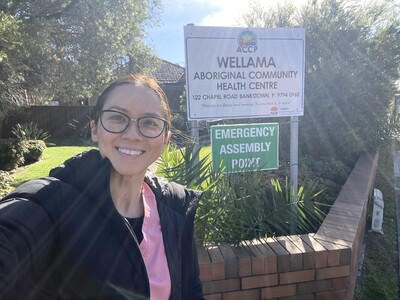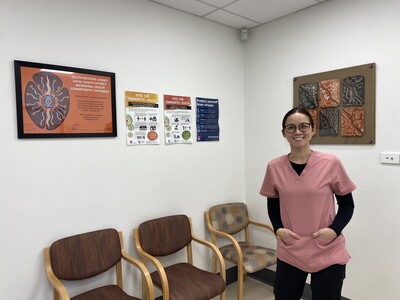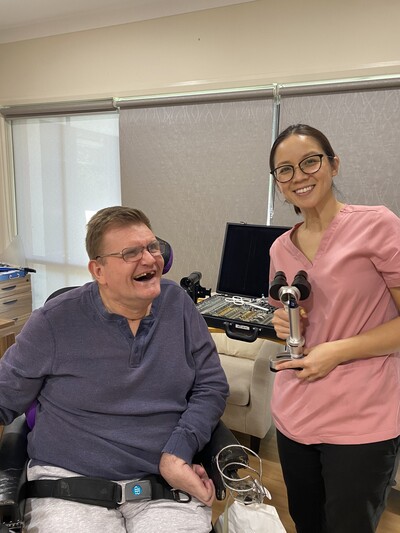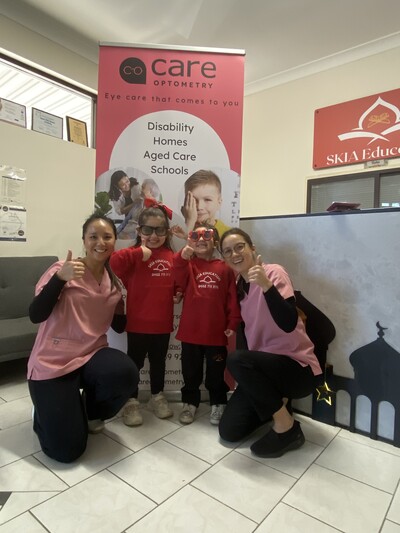A Day in the Life of a mobile optometrist

Linda Nguyen is the owner and founder of Sydney-based Care Optometry — a family-run mobile optometrists’ practice started in early 2020 with a vision to make eye care more accessible and inclusive for everyone. Graduating with a Bachelor of Optometry from UNSW in 2006 and subsequently obtaining additional qualifications to become an endorsed Ophthalmic Medicines Prescriber, Linda’s practice includes disability and aged care, assisting children in schools and daycares, and those recovering from traumatic brain injuries in rehabilitation hospitals. A finalist in the Allied health — Individual Leadership category of the 2025 HESTA Excellence Awards, here’s a day in her life.
06:45 As a busy mobile optometrist also juggling motherhood, wake-up hour means juggling the kids’ breakfasts, uniforms, hair and lunch boxes. Thankfully super-dad is also on call to move the kids along and help get them to school.
07:30 Running a portable clinic means you need to pre-plan your day to the tee and this includes using pre-filled forms so I know what is in store for the day and having equipment charged the day before. The first hour involves loading the car up with all the relevant kits for the day and also mental preparation for any difficult cases. Mobile clinics can range from a class of young children to seeing elderly patients in their homes. It may also involve visiting a satellite clinic location or seeing non-verbal individuals living with disability. Or it may be a combination of the above! From fun toys to disability-friendly portable equipment and a variety of frames for different tastes, you would be surprised how much you can fit in a couple of suitcases. Once the boot is packed it’s time to hit the road.

09:00 On this particular day, I am visiting the local Aboriginal health service. I first check in and assess the patient list for the day and have a quick catch-up with the healthcare workers with any issues that need my attention. Then a busy clinic usually involves juggling eye tests, dilated eye exams and selecting of glasses, and then reports to various providers including GPs, ophthalmologists and the Brien Holden Foundation, which are all part of this chronic healthcare team.

12:30 Time for a quick lunch and at this point I may try and squeeze in a little admin time, including answering patient enquiries. Then it’s time to hit the road again.
13:30 The afternoon is spent seeing patients in homes and we try to schedule them in the same localities where possible to make time on the road more efficient. Having the privilege to see patients in their homes allows me to better understand their situation and better manage their individual needs. I gain information such as their occupational set-up, lighting and the home care supports available to help form my treatment plan. Some home visits require thinking outside of the box and adapting the tests for the patient’s comfort and safety. If you asked me: can I test patients whose only position is lying down? Yes, absolutely.

However, a mobile optometry visit extends beyond an eye exam alone. Yes, it is a great feeling to be able to allow the patient to see ‘20/20’ for TV or reading, or help a patient resolve their doubled vision. It is even more rewarding knowing that improving vision means providing access to communication and a sense of belonging to the outside world. Good vision can mean maintaining mobility and independence. To my home-bound patients, this is everything. And seeing them get as excited as I do, is really nice.

17:00 Getting back to my home office means unpacking the car, getting new spectacle orders ready to be sent the next day and setting electronic equipment to charge.
17:30 Time to get back to the family headspace and get dinner sorted. This is a great time for everyone to unpack their day. Some nights I am very fortunate that hubby has cooked a warm dinner ready and waiting for me in the oven, thanks again super-dad. The kids have hopefully finished their homework by now!
18:30 I call this the ‘night shift’ and every tired parent out there knows this hour. It’s kitchen pack-up time, lunch box and bag clean-outs, it’s the picking up of random toys from the floor and a night vacuum.
19:30 Time to squeeze in a little more family time including board games, helping with any homework or some television (if they are lucky!). Another extension of the ‘night shift’ is trying to get the kids in bed on time!
21:00 Unwinding time finally means my husband and I can catch up again and get up to speed with the news of the day.
22:00 Then the quietest part of the night is where I can get into my creative headspace when I am conjuring up my next great idea, quietly cleaning or maybe both!
Using social prescribing as 'a script against loneliness'
The Royal Australian College of GPs is supporting social prescribing as a health intervention...
Raising 'tech neck' awareness this Spinal Health Week
For Spinal Health Week, 26 May–1 June, the Australian Chiropractors Association has...
New Aged Care Act: six things providers need to know
On 1 November, the new Aged Care Act comes into effect, marking once-in-a-generation reforms. A...


![[New Zealand] Transform from Security Awareness to a Security Culture: A Vital Shift for SMB Healthcare — Webinar](https://d1v1e13ebw3o15.cloudfront.net/data/89856/wfmedia_thumb/..jpg)
![[Australia] Transform from Security Awareness to a Security Culture: A Vital Shift for SMB Healthcare — Webinar](https://d1v1e13ebw3o15.cloudfront.net/data/89855/wfmedia_thumb/..jpg)




